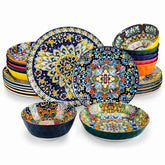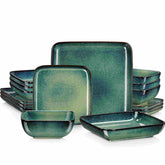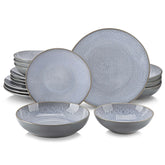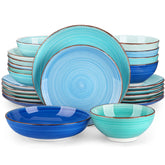What Is a Dutch Oven and Why Is It So Special
Navigation
From boiling water for pasta to cooking a full meal pot roast, the Dutch oven is celebrated worldwide for its functionality in various cuisines. With its universal appeal in cooking, a Dutch oven is undoubtedly one of the most versatile cookware you can own.
Now, you must be wondering what a Dutch oven is and why everyone wants to buy one. This post will cover everything from what a Dutch oven is to why it is so special. So read along!
What is a Dutch Oven?
By definition, the Dutch oven (also known as the French Oven or Cocotte) is a large, cast iron cooking pot that comes with a fitted lid and a seasoned or enamel-coated nonstick surface.
While it may have a hefty price tag, its versatility in cooking and aesthetics make it worth every penny. A Dutch oven in your cookware setting can accomplish lofty culinary goals. We'll discuss its versatility and usefulness in withstanding a variety of cooking techniques in a while. But before we do, let's explore the Dutch oven design.
Dutch Oven Design
The Dutch oven features a thick-walled body supported by protective handles. It comes with a tight-fitting flat lid that has many uses other than covering!
By looks, a round or oval Dutch oven will look like a regular stock pot, but it has a wider base and shorter walls, making it perfect for cooking any type of cuisine. Its design makes it an incredibly versatile cookware essential for every household.
Moreover, from a teeny ¼-quart to a staggering 13 quarts, Dutch ovens come in various sizes, each with its own set of uses.
Dutch Oven History
While the Dutch oven is still well in trend in 2024, its history can be traced back to the Netherlands in the Pre-17th century. Back then, the Netherlands led the cookware industry by making top-of-the-line items such as the Dutch oven. In the pre-17th century, pots and pans were crafted from expensive materials like brass and copper, making them exclusive to only those who could afford them.
An English inventor realized that cast iron could be a much cheaper alternative, but he still needed to make the pot in a Dutch way. He started making cast iron pots, using the Dutch process, and hence, they continued to be called Dutch ovens.
Why is a Dutch Oven So Special?
The Dutch oven was soon all over the world, and it still is. So, what is so special about it? Let's explore its features.
Versatility
One of the main reasons why everyone talks so highly of Dutch ovens is their ability to be useful in any cooking situation!
Whether you're in the mood to bake bread, fry chicken wings, or cook tasty stew, the Dutch oven has got you covered. But its popularity lies in its low and slow cooking characteristics, making it perfect for braising and ideal for building flavor in stews or chili.
A Dutch oven is so versatile due to its high walls, exceptional heat retention, and substantial depth.
Heat Retention and Distribution
The Dutch ovens are exceptional in heat retention and distribution mainly because of their innate thick-walled design. While the thick walls take longer to heat, it evenly distributes heat. Once the Dutch oven gets heated, it evenly distributes the warmth throughout the vessel, making it perfect for slow-cooking meals like stews or braised meat.
Moreover, when you cook in a Dutch oven, the food stays warm for a long duration.
Flavor Enhancement and Moisture Retention
If you cook in a Dutch oven, you can even make Gordon Ramsay lick his fingers. The magic is not in your recipe but in the Dutch oven, which, with its tight-fitted lid, turns every dish into a flavor cuisine. But what really is the sorcery?
The tight-fitted lid helps retain moisture by creating a self-basting cycle, which allows the moisture to tenderize the food and enhance flavor throughout the cooking process.
Note: The self-basting cycle occurs when steam builds and has nowhere to escape the Dutch oven.
Durability
Apart from its versatility and flavor enhancement, the Dutch oven is also prominent for its durability. It is no surprise that it is one of the most reliable pieces in the cookware industry. It can be quite pricey, but if taken proper care of, it can serve you for decades.
Dutch Oven Materials
While Dutch Ovens are typically made of cast iron, they come in two varieties-unfinished cast iron or enameled cast iron.
The Dutch oven in unfinished cast iron resembles a simple cast iron skillet, with the entire body made of cast iron. On the other hand, enameled cast iron features a finishing of the enamel coating, giving it a non-sticky surface. Moreover, enameled Dutch ovens come in gorgeous hues, from bright red to cool, glossy blue. Check out our top-of-the-line 6.3QT enameled cast iron Oval Dutch Oven!
Compared to enameled Dutch ovens, unfinished cast iron is less visually appealing. Moreover, unfinished cast iron requires some extra attention when cleaning and is more prone to rust. But on the bright side, unfinished cast iron Dutch ovens are way more affordable than the enameled ones.
Conclusion
All in all, the Dutch oven is prominent in the cookware industry mainly for its versatility, durability, and its flavor enhancement qualities. If you don't have a Dutch oven yet, we suggest you buy one ASAP!
From baking banana bread to roasting meat to cooking stews to braising, you can use a Dutch oven to make any type of cuisine you want. It's the ultimate cookware that can replace any and all cookware in your house. So, wait no more and visit vancasso to browse through a variety of premium-quality Dutch ovens at affordable prices.
Read More













